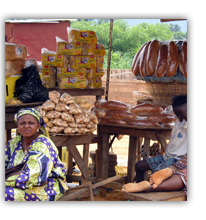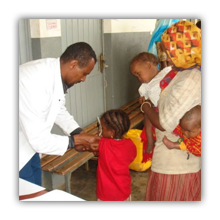Move your mouse over the pictures to learn more.

|

|
 |
Potential Effects on Incomes and Livelihoods for Poor Households:
Girls and women use transport disproportionately to fulfil domestic responsibilities. Improved road infrastructure and increased access to mass transport in rural areas could reduce women’s time burden on domestic chores, improve women’s access to employment, markets and income generation. This could in turn free up time and resources for girls to go to school while increasing family revenue for school fees. Better road infrastructure could allay safety and security concerns for women and girls, enabling more mobility for school and revenue generation.
Girls and women use transport disproportionately to fulfil domestic responsibilities. Improved road infrastructure and increased access to mass transport in rural areas could reduce women’s time burden on domestic chores, improve women’s access to employment, markets and income generation. This could in turn free up time and resources for girls to go to school while increasing family revenue for school fees. Better road infrastructure could allay safety and security concerns for women and girls, enabling more mobility for school and revenue generation.
Potential Effects on Access to and Quality of Services for Children:
An increase in the cost of mass transport (through increased regulation and safety standards for transport operators) would likely result in increased user fees. If fee increases for transport rise, choices might have to be made by poor, rural households on where to allocate resources and this could lead to decreased expenditure on nutritious food, health services or school fees for their children. Conversely, the quality of health and education services could improve if rural areas are able to attract more qualified personnel through increased access and infrastructure.
An increase in the cost of mass transport (through increased regulation and safety standards for transport operators) would likely result in increased user fees. If fee increases for transport rise, choices might have to be made by poor, rural households on where to allocate resources and this could lead to decreased expenditure on nutritious food, health services or school fees for their children. Conversely, the quality of health and education services could improve if rural areas are able to attract more qualified personnel through increased access and infrastructure.
Potential Effects on Social Capital and Child Protection:
With increased mobility among parents, child care and supervision of young children may fall to older children, reducing their school attendance, particularly for older girls. With decreased parental supervision and no access to child care, the risk of child neglect and abuse among poor, rural households could increase.
With increased mobility among parents, child care and supervision of young children may fall to older children, reducing their school attendance, particularly for older girls. With decreased parental supervision and no access to child care, the risk of child neglect and abuse among poor, rural households could increase.
For more information on CRIA tools and methodology, please consult:
UNICEF & World Bank Resource Pack on Integrating a Child Focus into Poverty and Social Impact Analysis
and
Integrating a Child Focus into Poverty and Social Impact Analysis (PSIA): A UNICEF - World Bank Guidance Note
